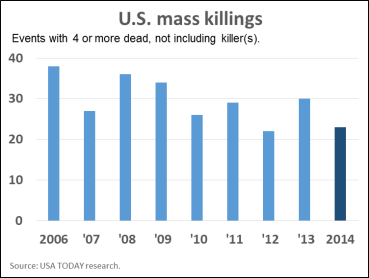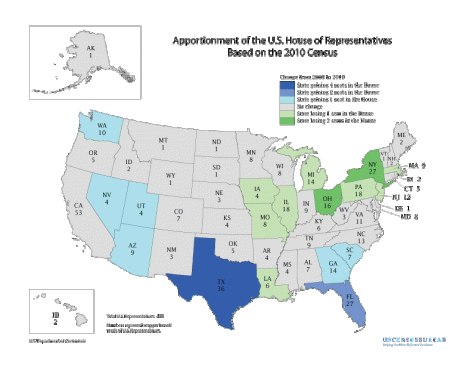Category Archives: Uncategorized
People power keeps shifting to Texas
Since the 2015 term of the House of Representatives just began today, it seems early to be thinking about its balance of power in 2023. The political industry never sleeps, however, especially over the big reset that comes after each census, when seats are redistributed among the states.
Hints come from Census Bureau estimates of 2014 state populations released recently. If done today with those estimates, reapportionment would shift a seat from Minnesota to Texas, according to Election Data Services, a Manassas, Va., consulting firm. That’s not much change compared with this time a decade ago, when five states already would have had to swap seats. Thank the slow economic recovery, which has delayed retirements, immigration, marriages, job relocations and the population shifts that they create.
With warnings about tentativeness, Election Data Services also projected House changes by 2020 if each state were to keep growing at its 2010-14 rate. Gainers of a single seat: Ariz., Calif., Colo., Fla., N.C., and possibly Oregon or Virginia. Texas would gain three seats. Losers of a single seat: Ala., Ill., Mich., Minn., Ohio, Pa., R.I., W.Va. and possibly N.Y.
Unlike much else in Washington, reapportionment can’t be lobbied, earmarked or filibustered. It’s in the Constitution (Article 1, Section 2). It has only been kicked down the road once (in the 1920s). The current formula was set in a 1941 law that has been blessed by the Supreme Court.
Political impacts aside, reapportionment is a gauge of long-term shifts in where we live.The 2020 pattern seems to be emerging, even if details aren’t clear yet: Fewer shifted seats (9) than the last two reapportionments (12 each). Losses in the Northeast and Midwest, scattered gains elsewhere.
But the pattern is patchy. For example, New York and Massachusetts are growing faster than Sun Belt states like New Mexico, Alabama and Mississippi.
And who knows what the next five years will bring? A decade ago, population shifters like Hurricane Katrina, the Great Recession and the fracking boom lay in the future. — Paul Overberg
It’s not so easy to count mass killings
Two years ago this month, a particularly horrific mass killing took place in a Newtown, Conn., school. We’re still struggling with how we cover these crimes:
— In September, an FBI report on so-called “active shooter” cases was widely misreported to show that “mass shootings” were increasing. A federal definition shared by several agencies defines “active shooter” as “an individual actively engaged in killing or attempting to kill people in a confined and populated area.” For its report, the FBI make two tweaks: To include cases where more than one person was shooting and to drop “confined” to include outdoor events. It’s worth pointing out that many of these cases don’t meet the FBI’s definition of a mass killing: four or more dead, not including killer(s).
The FBI just wanted tactical insight, so it also excluded whole categories of potentially qualifying events: “Specifically, shootings that resulted from gang or drug violence—pervasive, long-tracked, criminal acts that could also affect the public — were not included in this study. In addition, other gun-related shootings were not included when those incidents appeared generally not to have put others in peril (e.g., the accidental discharge of a firearm in a school building or a person who chose to publicly commit suicide in a parking lot).”
Wrote the authors: “The study does not encompass all mass killings or shootings in public places and therefore is limited in its scope.”
Resulting headlines at major news organizations: “Mass Shootings on the Rise, FBI Says”; “Mass Shootings on the Rise, New FBI Study Shows”; “FBI: Mass shooting incidents occurring more frequently”; “FBI study: Deaths in mass shootings increasing.” (Search users beware: A recent check finds many still uncorrected stories on the Web.)
 — We continue to update USA TODAY’s interactive graphic of mass killings, published a year ago. We use the FBI’s definition. This year we’ve counted 23, a bit below the average of 30 from 2006-13. (More on that in a minute.) Most weren’t big news outside the towns where they occurred. Typically, they involved a man targeting family members and acquaintances. Most involved guns but a handful did not. None involved semiautomatic rifles, although police haven’t revealed the weapon in a few cases. Almost half of the suspects were found dead or were killed by police. In all, 104 victims were killed, 12 more wounded. Continue reading
— We continue to update USA TODAY’s interactive graphic of mass killings, published a year ago. We use the FBI’s definition. This year we’ve counted 23, a bit below the average of 30 from 2006-13. (More on that in a minute.) Most weren’t big news outside the towns where they occurred. Typically, they involved a man targeting family members and acquaintances. Most involved guns but a handful did not. None involved semiautomatic rifles, although police haven’t revealed the weapon in a few cases. Almost half of the suspects were found dead or were killed by police. In all, 104 victims were killed, 12 more wounded. Continue reading
Hey Baby: What’s in a name
Earlier this year we published a story on the most popular 2014 baby names based on data from BabyCenter, a website that caters to expecting parents. It covers about 1 in 8 newborns.
Nothing wrong with that, but the names tend to skew white and trendy. We won’t have the complete 2014 list until spring, when the Social Security Administration publishes its own list, based on near-universal infant registration for SS numbers.
A comparison of 2013 top 10 boys’ lists shows, in order:
— BabyCenter: Jackson, Aiden, Liam, Lucas, Noah, Mason, Jayden, Ethan, Jacob, Jack.
— Social Security: Noah, Liam, Jacob, Mason, William, Ethan, Michael, Alexander, Jayden and Daniel.
There’s less difference for popular girls’ names. Sophia/Sofia, Emma, Olivia, Ava, Isabella and Mia rule both lists.
Is that because boys’ names tend to be less trendy? Or parents who choose more traditional names don’t bother to register on this website? In any case, we’re left with a subtly white-centric view of the nursery. Outside of the top names, the lists diverge sharply, especially for traditional names. And BabyCenter’s list is missing several Hispanic names in the top 100, like Angel, Jose, Luis and Juan.
You can also see this in names that moved up the most, according to the SSA list: more ethnic-sounding names such as Jayceon and Castiel for boys, and Daleyza and Freya for girls.
And not for nothing, the names of the Data Team members are past the bubble: All of our names have been losing popularity since at least 2000. Our trendiest member: Paul, who last broke the top 100 (at number 100) 14 years ago.
—Jodi Upton and Paul Overberg

Welcome to our blog!
Being a data journalist sometimes feels like living on a desert island.
On the one hand, it is sometimes a welcome respite from the daily grind of news reporting. On our island, we often get a little extra time to think about stories and the data that we can use to tell them. That’s a fresh breeze compared to most beat reporters.
But on the other hand, we sometimes feel a little isolated. We see data –and conclusions — get stretched and mashed into shapes it really shouldn’t take. We see shortcuts taken and warnings ignored, even among our fellow journalists. And sometimes we have a few ‘doh!’ moments of our own.
So this is our blog about those moments. Data that could be better, news that could be sharper, illuminations that could be illumier. It’s not a scold. It’s a place to sort out how we use data in the news media in the hopes that all journalists become more comfortable using data well. We hope to be more teachy than preachy.
To start, the USA TODAY data team will share posts: Paul Overberg, Meghan Hoyer, Chris Schnaars and MaryJo Webster. Hopefully we’ll bring in guest bloggers from our Investigative team, the Network and others from the data journalism tribe.
We hope you’ll enjoy following us, and bring us a little closer to the mainland. Now if we could just get the professor to fix that damn radio.
Jodi Upton, USA TODAY Data Team lead


